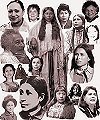 |
Ancient
Voices
A
Museum to honor the least known people in North America, the Original
Tribal Women |
Pottery
Jemez
The Pueblo of Jemez (pronounced "Hay-mess" or traditionally as "He-mish") is one of the 19 pueblos located in New Mexico. It is a federally recognized American Indian tribe with 3,400 tribal members, most of whom reside in a puebloan village that is known as "'Walatowa" (a Towa word meaning "this is the place"). Walatowa is located in North-Central New Mexico, within the southern end of the majestic Canon de Don Diego. The Pueblo of Jemez is an independent sovereign nation with an independent government and tribal court system. Traditional matters are still handled through a separate governing body that is rooted in prehistory. This traditional government includes the spiritual and society leaders'
Jemez potters have come a long way in the last 20 years. They have staged a renaissance in pottery making, and they have done this using "traditional" techniques. Having been out of the picture when Nampeyo and Maria were first recognized, in the early 1900s, they are making a name for themselves, now.
Jemez people are internationally known for arts and crafts. Pottery such as bowls, seed pots sgraffitto vessels (elaborately polished and engraved), wedding vases, figurines, holiday ornaments, and their famous storytellers are now in collections throughout the world.
"I talk to the clay. I put my mind to making good pots. I treat them like human beings so they won’t be broken."
|
Mary Small
1945 -
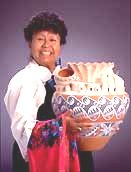
Mary Small was born in 1945 to Seriaco and Perfectita Toya, all members of the Sun Clan. Kal-La-Tee, "New Indian Basket" is from Jemez Pueblo and has been an active potter since the 1950s working with matt polychrome jars, bowls, wedding vases, storytellers and miniatures. She was taught traditional pottery making by her mother Perfectita. She learned to work clay in the traditional coiling method of her ancestors, using clays dug on Jemez land and hand-painted with clay glazes which are fired outdoors over cottonwood coals after each application of color. Her pots are flawless with perfect shape, color and graphics. Mary is a Master Potter. She a wonderful person who has worked for decades to achieve the quality of her work. She and her husband, Ivan Small, developed the delicate matte gray glaze that distinguishes their pieces from other Native American potters.
Mary says, “I ask a blessing for each stage. Before beginning to make the pottery, I ask Mother Earth to give me good clay because my belief is strong. I respect the potteries. They give me bread and butter for my family. I talk to the clay. I put my mind to making good pots. I treat them like human beings so they won’t be broken. If an accident happens, I bury the piece and give it back to Mother Earth. In return I’ll get a nice pot. I was taught that by my mother.” She adds, “When my potteries are finished, they are blessed. They have power. Whoever buys the pottery should have a nice home, a happy life, and a sacred object because there are a lot of prayers in my potteries. Each piece of pottery is a contribution to the interaction with nature so necessary for protection of the people on earth.”
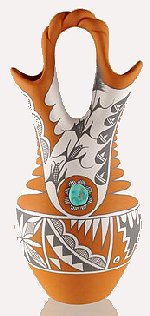
Mary Small’s pottery is featured in the Heard Museum, the Denver Museum of Natural History and the Smithsonian Institution, as well as in permanent collections throughout the country. She has received various awards from shows such as Santa Fe Indian Market, Powhatan Renape Nation Indian Arts Festival, Heard Museum Show, New Mexico State Fair,and the Gallup Inter-tribal Indian Ceremonial. She was also named the Indian Arts & Crafts Association Artist of the Year for 2002,
|
Mary Louise Eteeyan
1942 -
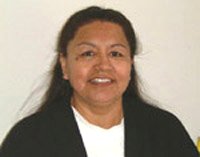
Mary Louise was born into the Jemez Pueblo in 1942. She was inspired to learn the art of pottery making, by observing several of her friends hand coil their pottery. She began experimenting with pottery making in 1978 at the age of 34.
Mary Louise specializes in the handmade Jemez style butterfly bowls with lids. Mary Louise Eteeyan is famous for her butterflies. She uses butterflies in almost all of her pottery in one form or another. Sometimes she paints them sometimes she makes butterfly shaped lids, but it's always a butterfly. She also hand coils wedding vases and various shapes of pottery. Mary gathers her own clay from the grounds within the Pueblo. Then, she soaks the clay, grinds, sifts, cleans, mixes, hand coils, shapes, hand paints, and fires her pottery the traditional way, outdoors.
Mary Louise uses all natural pigments to construct her pottery. Her coiling and painting skills are among one of the most precise around today.
Mary signs her pottery as: Mary Louise Eteeyan, Jemez.
Mary is related to the following artists: Anna Marie Sendo (mother) and Kimberly Eteeyan (daughter).
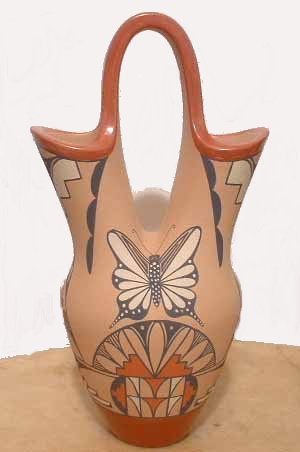
|
Marcella Yepa
1964 -
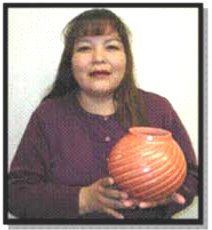
She was born into the Jemez Sun Clan on the Jemez Pueblo in 1964.
Marcella began working with clay at the age of 19. She was inspired to learn the art of working with clay from her aunt, Alvina Yepa. Alvina shared with Marcella all the fundamentals of hand coiling traditional pottery. She also taught her which hills provided the best clay to work with and special techniques to construct her art. Marcella gathers her clay and other natural pigments within the Jemez Pueblo. The lucrative aspect also inspired Marcella to become an artisan and establishing her own unique style of art gave her a feeling of self worth.
Marcella specializes in hand coiled contemporary stone polished redware and tanware melon swirl pots, jars, and wedding vases.
Marcella's techniques are traditional. She soaks the clay, grinds it to a powder form, cleans the clay, hand mixes, hand coils, shapes, carves the pottery, polishes her pottery with a stone, and fires her pottery outdoors with cedar chips. She hand coils many shapes and sizes of pottery like wedding vases, ollas, and traditional shapes. A new variation on her usual style is the introduction of mica slip to cover some of her swirl pots.
She signs her pottery as: M. Yepa, Jemez, or Marcella Yepa, Jemez.
She is related to the following artists: Emma Yepa (cousin), and Lawrence Yepa.
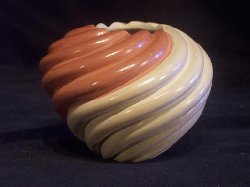

|
Storyteller potters
Linda Lucero Fragua
1954 -
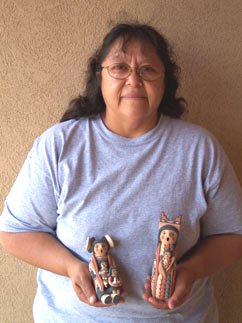
Once upon a time, Linda Fragua went into the desert and prayerfully dug from the secret stash of red clay that lies near her home in the Pueblo of Jemez, N.M.
Then she lovingly molded that clay into a storyteller doll-20 children on its spacious lap.
The doll, which speaks volumes about her people's way of life, soon found itself on its way to Sun Valley where it wound up in Don Hartwich's Dream Catcher Gallery.
And there it awaits a loving home from someone who will cherish what such dolls mean to Fragua's people.
Wood River Journal
Linda is a life-long resident of Jemez Pueblo and learned the art of pottery making from her mother, Rebecca Lucero, who had been making pottery since she was in her teens. All of Fragua’s pottery is made with natural materials from the earth at Jemez Pueblo, including her paints and clay. According to Fragua, “I am very interested in continuing the art of pottery making which has been a part of my culture for many years.”

She is currently passing the tradition onto her immediate family, including her husband, two daughters (1 adjacent) and son.
Linda was awarded 2nd Place – Pottery at the Tesoro Foundation’s 2005 and 2006 Indian Markets. |
Chrislyn Fragua
1977 -
"My Grandmother, (Rebecca Lucero) once told my mother to always be in a good mood while forming our pottery. As you can tell from our expressions on our work, we always enjoy making our pottery."
Chrislyn is a 30 year old Native American potter from the reservation of Jemez Pueblo. She has been making pottery, storytellers and other figures since the age of twelve. Her mother Linda Lucero-Fragua took the time to teach her how to make pottery and taught her to get the clay from the hills of Jemez. She is now passing the skills on to her daughter, Anissa Tsosie who is now nine years old.
The clays and paint the Jemez potters use come from the surrounding areas of Jemez Pueblo so everything they use in the process of making the pottery is natural. Her favorite part of making pottery is doing the formation. Once she starts working with the clay she doesn't know what she will be forming and she usually gets different ideas. She has won a couple of ribbons from the Eight Northern Art Shows and plans to accomplish more in the near future.
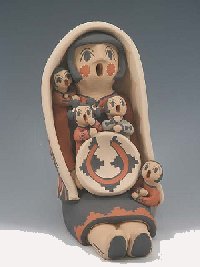

Pot below made by Chrislyn's grandmother Rebecca Lucero

|
|
http://www.jemezpueblo.org/history.htm
http://www.wrightsgallery.com/artists.php
Please click on the links below to see the various pottery families.
|













